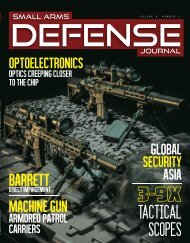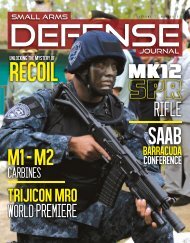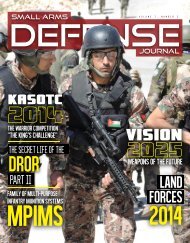SAR 18#6
You also want an ePaper? Increase the reach of your titles
YUMPU automatically turns print PDFs into web optimized ePapers that Google loves.
PISTOL CALIBER CARBINES:<br />
NOT ANOTHER AR-15<br />
By David Lake<br />
Since the advent of repeating arms<br />
and cased ammunition, the goal and<br />
purpose of small arms manufacturers<br />
has been to improve and even specialize<br />
those weapons. Shoulder fired arms<br />
have to be divided into specific categories,<br />
ranging in size and power from the<br />
highly compact PDW, up to the robust<br />
anti-materiel rifle. In between these extremes<br />
you’ll find submachine guns, carbines,<br />
assault rifles, light machine guns,<br />
heavy machine guns, shotguns, launchers,<br />
and sniper rifles. Each represents a<br />
unique field of study, development, and<br />
application. Military and law enforcement<br />
will have access to, and a purpose<br />
for, all of the above weapon types. The<br />
civilian consumer will generally have<br />
less choice; whether collector, competitor,<br />
hobbyist, or hunter. The vast majority<br />
of guns lining the retail shelves today<br />
can be described with only two letters:<br />
AR. The overwhelming array of variants<br />
and versions of the AR-15 dominate our<br />
current gun market. The simple fact is<br />
that the AR-15 is so versatile it can be<br />
adapted to fill almost any role. As the<br />
gun-buying public supports the industry<br />
focused on the AR-15, we continue to<br />
see growing specialization and development<br />
for that platform. It would seem<br />
that the development and marketing of<br />
other weapon types is given less attention<br />
by most manufacturers of arms. It<br />
would seem that a well-developed carbine<br />
dedicated to firing a pistol cartridge<br />
does not command as much attention in<br />
the retail market.<br />
We should discuss the small arms<br />
arsenal of the two world wars. In World<br />
War One, scattered among the Mausers<br />
and Springfields and Carcanos, and<br />
Enfields and Hotchkiss and Maxims and<br />
Vickers of the day, there were the M15<br />
Villar-Perosa, and the MP18 Bergmann.<br />
They were short, light (by comparison to<br />
the infantry rifles of the day) and fired<br />
pistol cartridges at the rate of a machine<br />
gun from very high-capacity magazines.<br />
In World War II we still see the presence<br />
of high-powered infantry rifles; but now,<br />
well developed on all fronts is the submachine<br />
gun. It is important to grasp this<br />
point that based on the lessons of World<br />
War One; every country that would be<br />
involved in the Second World War would<br />
develop and field a pistol caliber shoulder<br />
fired small arm. Government and<br />
military bodies had learned that battle<br />
engagements were typically happening<br />
at close to intermediate ranges. The infantry<br />
rifle’s size and power and potential<br />
to hit the horizon were proven unnecessary<br />
in most situations. The battlefield<br />
would eventually adopt a lighter, smaller<br />
rifle that could sustain automatic fire<br />
and hold 30 to 40 rounds and hit a mansized<br />
target up to 150 yards away. To<br />
properly illustrate the proliferation of the<br />
pistol caliber carbine, here’s the short<br />
list of sub-guns from WWII: Thompson,<br />
M3 Grease Gun, Reising, Beretta<br />
1918, Moschetto 38, Sten, Sterling,<br />
Lanchester, Owen, PPD-34, PPD-38,<br />
PPD-40, PPS-42, PPS-43, PPSH-41,<br />
UD-M42, LAD, Nambu type 100, Suomi,<br />
MAS 38, Ribeyrolle, Danuvia, Orita, Bechowiec,<br />
Blyskawica, Volks MP3008,<br />
MP28, MP34, Erma MP35, MP35 Bergmann,<br />
MP38, MP40, and MP41 etc.,<br />
just to get the list started. Consider<br />
that 24 years prior to the start of WWII,<br />
only 2 submachine guns saw their start<br />
in World War 1. We need not argue in<br />
support of the efficacy and practicality<br />
of the SMG. History speaks well to that<br />
effect, by the marked proliferation of this<br />
class of weapon.<br />
The world’s militaries would eventually<br />
adopt the “assault rifle,” which<br />
1<br />
Right:<br />
1. 50 yards with 124 grain remanufactured bulk ammunition from the Thureon.<br />
2. 50 yards with 124 grain remanufactured bulk ammunition from the TNW.<br />
3. 50 yards with 147 grain FMJ from the Thureon.<br />
4. 50 yards with 147 grain FMJ from the TNW.<br />
<strong>SAR</strong> Vol. 18, No. 6 84 Nov., Dec. 2014









